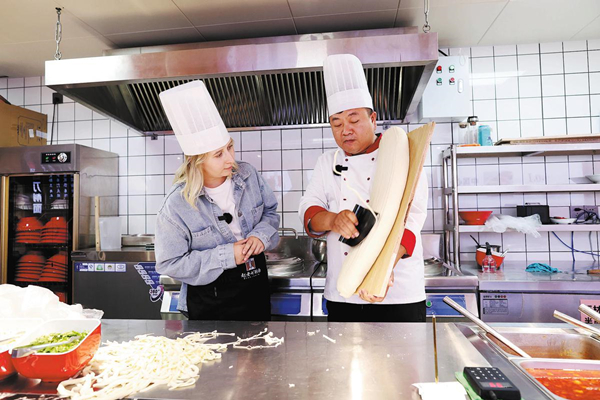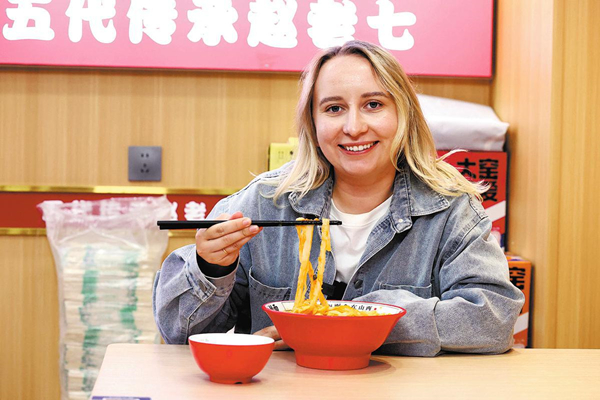'Knife-cut noodle' chef slices way to success
Zhao Xiping carries on family legacy as a fifth-generation inheritor of time-honored technique in Shanxi province

Zhao Xiping displays his noodle-cutting technique to Diana Pukhova, a Russian diner, in his noodle shop in Taiyuan, Shanxi province. ZHU XINGXIN/CHINA DAILY
The northern province of Shanxi, where the mighty Yellow River slices through the Loess Plateau, has long been considered as the heartland of cooked wheaten food in China.
With a culinary history dating back centuries, Shanxi boasts over 1,000 distinct varieties of wheaten dishes, each a testament to the region's deep-rooted connection to this versatile grain.
Among them, daoxiaomian, or "knife-cut noodles", is undoubtedly the most famous. The dish, which was first made during the Yuan Dynasty (1271-1368), is a testament to the region's rich culinary heritage and its generations of skilled noodle masters.
In 2008, the technique behind the dish was added to the national list of intangible cultural heritage.
Zhao Xiping, 43, is a fifth-generation inheritor of Zhao Laoqi's knife-cut noodles legacy. Zhao Xiping honed his skills from a young age, learning the secrets of this treasured craft from his father in Datong, Shanxi, where the first Zhao Laoqi noodle shop opened.
When he was 18, he decided to become a professional noodlemaker. Armed with expertise garnered from his ancestors, he ventured to Taiyuan, the provincial capital, in 2004 to bring the family's brand to more diners.
"In Shanxi, every family knows how to make knife-cut noodles," Zhao said. "Our family's recipe originated in the Qing Dynasty (1644-1911). It's a legacy passed down through generations, and now it's in my hands."
Every day starting at 11 am, Zhao Laoqi's Knife-cut Noodle Shop comes alive and is soon bustling with activity.
Zhao Xiping and members of his team are busy working in the kitchen. With each slice, as thin as a silverfish, gracefully arcing through the air before landing in the boiling water, Zhao's hands paint a mesmerizing picture of culinary artistry. The rhythmic movements of the knife against the dough, the little splashes of the noodles hitting the hot water and the tantalizing aroma of the food filling the air create an immersive experience for customers.

Zhao works in the kitchen of his restaurant. ZHU XINGXIN/CHINA DAILY
The secret lies in the dish's meticulous preparation. Zhao expertly combines water and flour, kneading the dough until it reaches the perfect consistency.
His method: "1 jin (500 grams) of flour, 4 liang (200 grams) of water, knead at dawn for the best flavor". The moment of truth arrives as the knife dances across the dough, effortlessly gliding with an impressive speed of 200 slices per minute, each noodle a precise 60 centimeters in length.
Recalling his early days, Zhao said he was initially drawn to the art of knife-cut noodles simply because of his love for cooking and the satisfaction he received from creating delectable dishes.
However, as he matured, he realized the deeper significance of his family's legacy.
The realization dawned on him during his travels outside of Datong, where he found that knife-cut noodle shops were still a rarity.
After finding initial success when he opened his shop in Taiyuan in 2004, Zhao experienced a series of setbacks. He launched a new branch in 2006 and another in 2007 in the Shanxi capital, but the expansions proved challenging, he said.

Pukhova enjoys a bowl of knife-cut noodles at Zhao's restaurant. ZHU XINGXIN/CHINA DAILY
Improper site selection led to a lack of foot traffic, so he had to temporarily close them all in 2007. Determined to learn from his mistakes, he traveled across the country to look for business opportunities, study business management and explore different culinary traditions.
A pivotal moment came during a conversation with a friend, who suggested that he highlight the cultural significance of knife-cut noodles and his family's history with the dish at his restaurants.
He took his friend's advice and reopened his noodle shops in 2008 with decorations celebrating the business tradition of Shanxi merchants and the culture of the region and the dish.
Today, stepping into a Zhao Laoqi restaurant is an immersive experience. Zhao Xiping has managed to transform moments of enjoying a traditional delicacy into a cultural experience.
After meeting and talking with Diana Pukhova, a Russian woman who studies at Shanxi University, Zhao said he is thinking about introducing knife-cut noodles to other parts of the world.
"I am planning to bring the noodles to Russia," he said. "I think we can bridge cultures through the universal language of food."
He also plans to establish a training center in Taiyuan and pass on his skills and knowledge to a new generation of noodle masters.
Wang Wendong contributed to this story.
Contact the writers at zhuxingxin@chinadaily.com.cn



